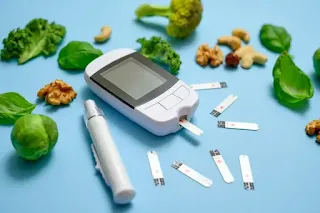Type 2 Diabetes: Causes Symptoms Subtypes & Treatment
 |
| In someone with type 2 diabetes, this system doesn’t function correctly. Either your body doesn’t produce enough insulin, or your cells become resistant to it .(Getty)/ Aljazeera |
Type 2 diabetes is a chronic metabolic disorder characterized by impaired insulin production or insulin resistance, leading to elevated blood glucose. In people with type 2 diabetes, the body either doesn’t produce enough insulin or its cells stop responding properly. This disruption can damage organs, nerves, and blood vessels over time.
What Happens in the Body?
Normally, your pancreas releases insulin in response to rising glucose from food. Insulin helps glucose enter cells for energy. In type 2 diabetes, this system breaks down: insulin production decreases and/or cells become resistant. Recent research identifies inflammation, oxidative stress, endoplasmic reticulum stress, and fat deposition as key pathways leading to insulin resistance and β‑cell dysfunction .
Recent Scientific Advances
- Molecular fingerprints of insulin resistance: A May 2025 study in Cell found that insulin sensitivity varies at the molecular level even among healthy individuals, paving the way for precision medicine in diabetes .
- Tirzepatide (Mounjaro/Zepbound): Dual GIP/GLP‑1 agonist approved in 2022, shows superior A1C reduction and weight loss versus semaglutide and insulin. Early use emphasizes personalized treatment targets .
- Orforglipron – 2025 milestone: Oral GLP‑1 agonist from Eli Lilly, last month’s phase 3 results show significant A1C reduction and ~7 kg weight loss in 40 weeks, lowering cost and boosting accessibility .
- ReCET + Semaglutide: A new electroporation therapy combined with semaglutide eliminated insulin needs in 86% of patients in early trials .
- Smart insulin (NNC2215): Glucose‑sensitive bioengineered insulin under development may reduce risk of hypoglycemia .
- Continuous glucose monitoring & automated insulin delivery: ATTD 2025 emphasized breakthroughs in CGM, pumps like Omnipod 5 for type 2 diabetes, and AI‑driven insulin algorithms .
- AI in early diagnosis: ECG‑DiaNet (Apr 2025) combines ECG data and risk factors to improve early type 2 diabetes prediction (AUROC 0.845) .
- Epigenetics & metabolic memory: Methylation patterns and histone modifications contribute to lasting organ damage even post-glucose control .
Subtypes of Type 2 Diabetes
- MARD – Mild age‑related; common in older adults.
- MOD – Mild obesity‑related.
- SIDD – Severe insulin deficiency; low BMI.
- SIRD – Severe insulin resistance; higher complication risk.
- Prediabetes – Early stage reversible through lifestyle, affecting millions.
Symptoms & Risk Factors
Watch for increased thirst, frequent urination, unexplained weight loss, fatigue, blurred vision, infections, and neuropathy. Risk factors include age (>45), family history, obesity, inactivity, high blood pressure, PCOS, gestational diabetes, smoking, and ethnicity .
Diagnosis
Common blood tests include:
- Fasting Plasma Glucose ≥126 mg/dL
- A1C ≥6.5%
- Random Plasma Glucose ≥200 mg/dL
- 2‑hour OGTT ≥200 mg/dL
Treatment & Management
- Lifestyle: Balanced diet, weight loss, regular exercise.
- Medications: Metformin, GLP‑1/GIP agonists (semaglutide, tirzepatide, orforglipron), SGLT2 inhibitors.
- Smart insulin: Next‑gen glucose‑sensitive options (e.g., NNC2215).
- Technology: CGM, automated pumps (Omnipod 5), AI‑based insulin dosing.
- Holistic care: Personalize therapy early to prevent organ damage (concept of metabolic dysfunction syndrome) .
Prevention & Remission
Studies (US Diabetes Prevention Program) show that lifestyle changes reduce risk by 58%, metformin by 31%—benefits lasting over 21 years . Early intervention in prediabetes is key.
Complications & Associated Risks
Type 2 diabetes increases risk of chronic kidney disease, heart disease, hypertension, hyperlipidemia. A UK Biobank study found nearly double risk of pancreatic cancer and fivefold increase in liver cancer among women with new diabetes . Semaglutide may also lower Alzheimer’s risk .
Global & Future Perspectives
Prediabetes now affects 1/3 of US adolescents—urgent need for screening and interventions . Research in Africa is uncovering unique genetic pathways (e.g., ZRANB3) that may lead to better, more inclusive treatments .
Living Well with Type 2 Diabetes
Managing type 2 diabetes effectively means early detection, personalized therapies, smart use of technology, and adopting healthy habits. With these tools, many people enjoy full, active lives free from severe complications.
References & Sources
- Surpass-5: Tirzepatide vs Semaglutide in Type 2 Diabetes — New England Journal of Medicine (2025)
- SURMOUNT‑2 Phase 3 Trial: Tirzepatide Improves QoL in Obesity & T2D — PMC (2025)
- Orforglipron Phase 3 Trial in Early Type 2 Diabetes (ACHIEVE‑1) — New England Journal of Medicine (2025)
- Eli Lilly investor release: Orforglipron Phase 3 results — Lilly (Apr 17, 2025)
- Tirzepatide and Muscle Composition Changes in T2D Patients — Lancet Diabetes & Endocrinology (2025)
- Tirzepatide vs Semaglutide: Weight and Waist reductions at Week 72 — PubMed summary (2025)
- Review: Metabolic Benefits of Tirzepatide (SURPASS‑3) — ScienceDirect (2025) 7
- Meta‑analysis: Tirzepatide vs Insulin in T2D — International Journal of Obesity (2024)
- Wikipedia: Orforglipron (LY‑3502970) — Orforglipron drug profile (2025)
- Wikipedia: Tirzepatide (Mounjaro/Zepbound) — Drug uses, trial outcomes (2025)
- Business Insider: Eli Lilly’s Obesity‑Drug Strategy (Tirzepatide & Orforglipron) — BI (July 2025)
- Reuters: Lilly Pill Helps Diabetes Patients Lose 7.9% — Reuters (Apr 17, 2025)
- Financial Times: Orforglipron’s Phase 3 Results — FT (Apr 2025)
- Fierce Biotech: Oral GLP‑1 Orforglipron Delivers Ozempic‑like Efficacy — Fierce Biotech (2025)







Comments
Post a Comment